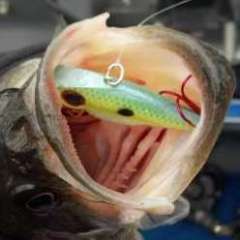I learned something this week while vacationing on a small lake in the California desert. There were no bluegill or crayfish in this lake, the only forage that lived in the water were shore minnows (looked to be mostly fatheads). The lake had bass & catfish, none of which looked like they missed a meal. The water had 3 feet visibility, which was a lot considering the maximum depth was 6 feet. All of the docks were in water less than 3 feet deep.
Although docks & weedlines 10 feet past the docks were the only cover, I had very little luck skipping docks or punching the weedlines. A majority of my fish came from casts in front of the docks, with TRD's, wacky senkos and a small spinnerbait. It produced multiple bass up to 4 lbs and aggressive catfish up to 5 lbs.
While watching the shore minnows getting chased by fingerlings one afternoon, I noticed that when they came to a dock, they would not swim into the shade or under the dock. In fact, they would swim out & around the dock, into deeper water, rather than venture into the darkness under the dock. Exactly why, I don't know, but it quickly explained why my small lures were hit where they were. That ambush zone, in the light instead of the shade, is where the predators were used to finding their prey in this lake. The prey was never in the shade, so if a predator was there, he was typically inactive, not feeding.
I also found out that midday, the catfish were under docks, but apparently resting, not eating. If you drove past the front of the dock, they would stream out like salmon migrating, sometimes in groups of 30 or more. If you skipped a lure under the dock, it would panic them. However, I learned to toss a hand full of dog kibble to the front of the dock. After 30 seconds, if anyone was home, they would wander out to investigate and could be caught with a well placed cast.






